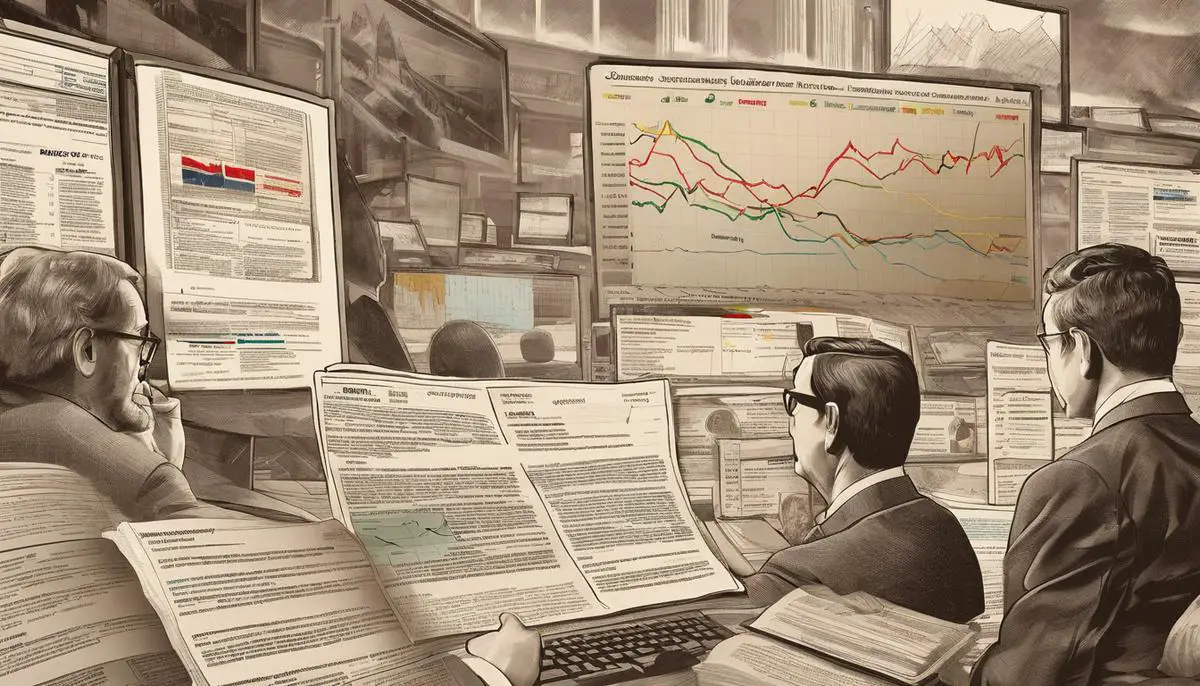Investing in the share market presents an exciting opportunity to grow your wealth, but it also requires comprehensive understanding and meticulous approach towards different aspects. We begin with the fundamentals, providing a clear, concise explanation of what the share market is and how exactly it is influenced by a multitude of factors including the economy, company news, and ongoing geopolitical events. Moving ahead, we define and elucidate the significance of technical analysis and market trends utilizing historical data, helping you to identify potential opportunities or pitfalls. We further delve into economies of risk, presenting risk management strategies and discussing methods to align them with your personal risk tolerance and investment objectives. Lastly, we explore the sphere of market psychology, focusing on investor sentiment and its potent influence on market trends.
Understanding the Market Basics
Harnessing the Wind of Change: How Fundamental Factors Influence the Share Market.
As seasons change, so too does the landscape of the financial world. Within this ever-changing environment, the share market plays a crucial role, serving as an indicator of a country’s economic health and a standard against which individual business performance is measured. For those in the business realm, comprehending these fluctuations is crucial to optimize investment decisions and strategies. With that in mind, let’s delve into the core fundamental factors known to significantly influence the share market.
1. Economic Factors:
A wide range of economic aspects directly impacts the share market. GDP, employment rates, inflation, interest rates, and economic policies all hold substantial sway. A healthy economy often points towards strong company profitability, which in turn can lead to a surge in share prices. Conversely, economic downturns may result in falling share prices. Understanding these economic indicators helps investors anticipate market outcomes, reducing risk and maximizing returns.
2. Market Sentiment:
The collective attitude of investors towards a particular market or asset, known as market sentiment, can have a considerable impact due to its ability to influence demand. High optimism often encourages buying, leading to an upswing in share prices, while prevalent pessimism can trigger a sell-off, thus driving prices down.
3. Company Performance:
A company’s financial health also directly influences the market. Factors like earnings, dividends, sales growth, and market share are just a few keys that stakeholders look at when making investment decisions. Strong performances typically lead to higher share prices, while subpar performances can cause shares to plummet.
4. Regulatory Changes:
In a world where businesses are heavily regulated, legislative changes often send ripples through the share market. Policies like tax reforms, trade tariffs, or environmental regulations can significantly impact businesses, driving share prices either up or down.
5. Global Events:
In this interconnected world, no country is an island. Global events such as geopolitical changes, wars, natural disasters and pandemics inevitably have knock-on effects on the share market. These events can create uncertainties or opportunities leading to volatility in the market.
There you have it – the fundamental factors that inject life into the otherwise passive share market, making it a living, breathing entity of interest to everyone in the financial and business world. Understanding these influences is a significant step to making insightful and prudential investment choices. The wind of change in the share market can be unpredictable, but with the right knowledge and preparation, one can set the right sail to harness its power.

Technical Analysis and Market Trends
Understanding the magic of technical analysis in predicting market trends
We live in an era where information is power, and in no industry is this truer than in the exciting world of investment. To conquer this space, one must decipher critical market indicators, a task that can be daunting for many. Here, technical analysis swoops in like a knight in shining armor, allowing savvy investors to make data-driven decisions based on logical, statistical, and mathematical concepts.
Technical analysis, at its heart, is the systematic evaluation of trends, patterns, and price movements. Like an insightful crystal ball, it illuminates potential investment opportunities and risks.
Deconstructing the mystery: How does technical analysis predict market trends?
What makes technical analysis remarkable is its reliance on patterns and indicators, informally termed as the language of the market. With the assistance of charts, indices, moving averages, and oscillators, we can decode this language, enabling us to predict market trends.
The fundamental principle behind technical analysis is historical market price and volume behavior often indicate future market behavior. Let’s dig a little deeper.
-
Price Patterns and Charts:
One primary weapon in a technical analyst’s arsenal is price patterns and charts, which aid in recognizing behavioral patterns. Ascending triangles, head and shoulders, candlestick formations – all compose a rhythmic symphony where each beat signifies a market signal.
-
Volume Analysis:
Trading volume is an essential indicator of the strength and durability of a market trend. High trading volumes suggest a strong trend while low volumes may indicate weak, unconfirmed patterns.
-
Moving Averages:
Moving averages, especially longer-term ones, work as reality checks. They filter out white noise, isolating the overall trend, and alert us to changes possibly indicating the commencement of new market dynamics.
-
Oscillators and Indicators:
Tools like the Relative Strength Index (RSI), Moving Average Convergence Divergence (MACD), Bollinger Bands, and Stochastic Oscillator provide insights when trends are likely to reverse, key to seizing entry and exit points in the market.
Technical analysis, when used judiciously alongside fundamental analysis, creates a powerful investment arsenal. It allows us to look beyond macro-economic conditions, company performance, regulatory changes, and global events, empowering us to make educated market predictions.
However, bear in mind, the perfect methodology is elusive – neither technical nor fundamental analysis can guarantee success. However, adept use of these tools can help tilt the scales in one’s favor, providing a competitive edge in the tumultuous world of trading.
This intricate dance between science and speculation, between logic and gut feeling is what makes investment a thrilling odyssey. So, as entrepreneurs and investors, let’s incorporate this precious wisdom of technical analysis in our investment toolkit and navigate the market’s rollercoaster ride with far-sighted vision and strategic precision.

Incorporating Risk Management Strategies
Investing in shares is akin to steering a boat across the vast ocean where dynamic factors like winds and waves shape the voyage. The share market can be unpredictable and mutably influenced by numerous elements beyond regulatory changes, global events, or standard economic factors. Hence, the need for sophisticated risk management strategies leaps into prominence to navigate through this varying sea of finance, essential to ensuring the safety of investors’ capital.
The heart of effective risk management strategies lies in incorporating a host of analysis tactics, including technical analysis. Recognizing indicators, understanding price patterns, and synthesizing information from charts and oscillators are paramount skills. With these tools, potential risk and return can be optimally balanced, providing investors with tailor-made strategies uniquely fit for their investing journey analogous to a navigational map guiding sailors across the sea.
Underpinning the tactical approach of technical analysis is the utilisation of volume analysis. This metric provides critical insights into the vigour behind market trends, significantly improving the precision of risk evaluation and management. Meanwhile, moving averages serve as the compass, sieving through the noise and subtly pointing towards the overarching trends.
However, oscillators and indicators come to life as the binoculars of an investor, enabling them to predict potential trend reversals and ascertain when to dive into or retreat from the market. They act as the lighthouse, guiding investors to the shores of beneficial decisions.
Although technical analysis holds in its grasp a plethora of tools and techniques, it should not be viewed as the ultimate solution. It is vigilant to remember that technical analysis has its own constraints. Relying on it alone may be equivalent to sailing a ship without considering potential storms on the horizon or the condition of the vessel itself.
Consequently, the fusion of technical and fundamental analyses emerges as the powerful weapon in an investor’s arsenal, like a ship equipped with state-of-the-art navigation systems and robust mechanisms. Acknowledging market sentiment and company performance, along with using the tools of technical analysis, paints a holistic picture of the investment landscape.
To sum it up, risk management strategies armed with the prowess of technical analysis and complemented by fundamental analysis are vital for any investor in the unpredictable world of share markets. They guide the investment journey, maximizing gains, and safeguarding against substantial losses, thus providing a well-navigated, risk-managed journey across the financial ocean. Like the diligent sailors they are, savvy investors continue to harness these strategies to ride the waves towards financial success.

Decoding Market Psychology
Understanding the psychology of the market opens up a fresh perspective on investment decisions, plunging the discerning investor into the intricate motivations of market behavior. Unraveling the market’s multifaceted personality fosters a unique sensitivity to subtler forces that nudge the market pulse – human psychology, investor sentiment, and behavioral trends – a potent tool in the shrewd investor’s kit.
It is recognized that markets, like the investors that inhabit them, are sentient entities with moods, fears, aspirations, and bouts of irrationality. By understanding these subtleties, investors can parse the emotional currents underlying market movements and exploit them for superior returns. For instance, the Fear and Greed index, a proprietary market sentiment tool, allows investors to gauge emotional extremes in the market and base their investment decisions accordingly.
In the realm of Behavioral Finance, key psychological tenets like loss aversion, confirming evidence, overconfidence, and herding play a decisive role. Loss aversion, a quirk of human psychology where investors are more affected by losses than equivalent gains, can often lead to poor investment decisions. Recognizing and accounting for these behavioural pitfalls allows an investor to better manage their portfolios.
Herding behavior, another psychological principle, could lead to notorious market bubbles and crashes – the dotcom boom and the housing crisis are classic examples. Identifying such behaviours can lead to terrific investment opportunities, for those who swim against the tide. In essence, understanding the market’s impressionability to investor sentiment, allows the savvy investor to position themselves advantageously amid the herd.
Drawing inferences from cognitive bias, where perceptions are distorted based on our individual cognitive predispositions, can also prove profitable. By understanding how cognitive biases influence investor decisions, one can avoid common missteps and craft more sound investment strategies.
Last but not least, understanding Market Psychology allows investors to formulate effective contrarian strategies – essentially going against the prevalent market sentiment. By recognizing when the market is overly pessimistic or optimistic, astute investors can capitalize on these market extremes.
Innovation, risk, competition, and creativity are not just the hallmarks of successful entrepreneurs and dynamic organizations but also of trailblazing investors. Understanding Market Psychology provides a powerful lever to navigate through the turbulent waters of investing. It is a compass that points toward unconventional wisdom, a perspective that breaks through the numbers and charts, and dives deep into the human psyche from where all market activity ultimately stems.
Ultimately, understanding Market Psychology is not a solution in itself but a potent tool that, coupled with technical analysis and fundamental insights, equips investors to make superior investment decisions in an increasingly complex and irrational market.

Understanding the share market is no small feat as it is powered by a complex interplay of factors firmly rooted in both numbers and human psychology. Recognizing this, becoming proficient in technical analysis is fundamental in making informed and strategically sound decisions. The importance of mastering sound risk management strategies is also a key takeaway, helping to guard your investments from unwarranted risks. A deep comprehension of market psychology further enables investors to navigate through the volatile currents of investor sentiments and avoid the pitfalls of emotional investing. By embracing this multifaceted knowledge, you step into a world of potentially fruitful investment in the share market.



